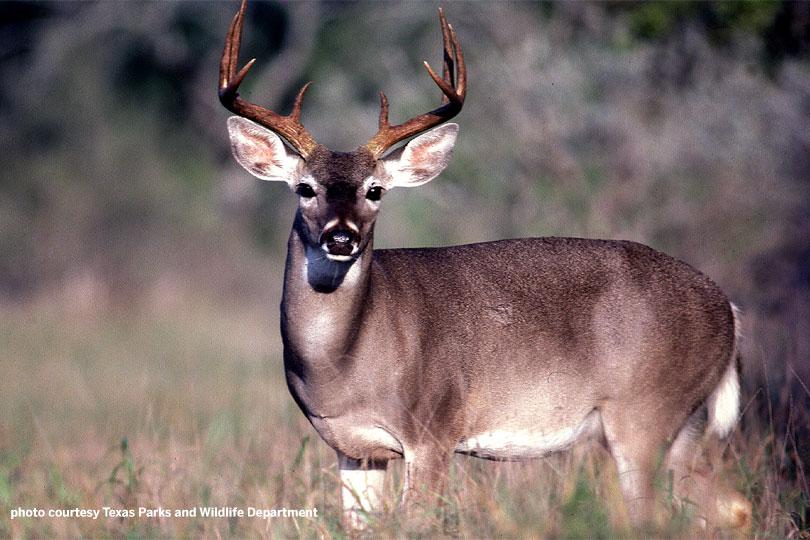By Jessica Domel
Multimedia Reporter
The Texas Parks and Wildlife Commission has approved several changes to deer hunting regulations for the upcoming season.
White-tailed deer
One of the approved changes clarifies the definition of buck and antlerless deer for hunters and law enforcement.
Alan Cain, white-tailed deer program leader for the Texas Parks and Wildlife Department, said this addresses the oddball tagging requirement scenarios like shed antler bucks, antler does or buck fawns.
“Staff propose(d) to clarify the antlerless deer are deer having no antler point protruding through the skin or a deer that has completely shed its antlers,” Cain said. “Buck deer will be defined as deer having antler point protruding through the skin or a deer having antler growth in velvet greater than one inch.”
Typically, male deer are referred to as bucks, while female deer are referred to as does. However, because of certain conditions like bucks that have lost their antlers, it may be difficult for hunters to determine the sex of a deer when hunting from a distance.
A hunter may think they shot a doe only to find out later that it is a male deer without antlers, which may be prohibited at that time.
Because of this confusion, years ago TPWD began using the term “antlerless deer” to refer to does and those deer without antlers.
“Bucks in velvet” has also been a long-standing conundrum, according to the proposal.
The recently approved change is designed to ensure the definitions are as clear and specific as possible.
The commission also approved changes to what hunters can use to prove a deer’s sex after harvest.
Before the change, hunters were required to keep a buck’s head.
“Staff proposed another option which includes the tail and unskinned skull camp with antlers attached, and again, that’s a second option,” Cain said. “This additional proof of sex aids in (Chronic Wasting Disease) CWD management, allowing the hunters to leave the most infectious part of the deer at the site of harvest, so we’re not hauling brain material around to other parts of the state, potentially spreading the disease.”
Cain said hunters may still keep the deer’s head for mounting, if they’d like. This is just an additional way to provide proof of sex.
The commission also approved definitions to two types of commercial cold storage facilities.
Mule deer
To curb excessive mule deer buck harvest, the commission approved a proposal extending mule deer antler restrictions in an additional 21 counties in the Panhandle.
Shawn Gray, TPWD mule deer and pronghorn program leader, told the commission the move follows a successful experiment that begin in 2018 and 2019 in seven southwest Panhandle counties.
“Prior to the experiment in the Southeast Panhandle, excessive buck harvest occurred primarily because of increased lease hunting and the popularity of mule deer hunting,” Gray said. “This excessive buck harvest affected the mule deer buck sex ratio in the area, with our survey data indicating a post-season sex ratio of about five does per buck.”
Intensive buck harvest also impacted the buck age structure.
“Because of this, staff received many requests from landowners and hunters to improve the buck age structure of the mule deer herd in this area of the Panhandle,” Gray said.
Using white-tailed deer antler restrictions as a model, TPWD staff collected data on mule deer during ongoing research projects and hunter-harvested mule deer to estimate the ear tip to ear tip spread of bucks standing in the alert position.
“Because the average ear tip to ear tip spread on Panhandle mule deer bucks is 21 inches, staff propose(d) to use a restriction with an outside spread of the main beams of 20 inches to protect younger age bucks,” Gray said.
Gray told the commission data suggest the antler restriction protects at least 80% of one-and-a-half to three-year-old bucks and about 80% of bucks four-and-a-half years of age or older would be harvestable.
“With this proposal, any buck with an outside spread of 20 inches or greater would be legal for harvest. Thus, any buck with a spread less than 20 inches would not be legal to harvest regardless of unbranched antlers,” Gray said.
The antler restriction does not currently apply to properties in the Managed Lands Deer Program (MLDP).
The counties impacted by the new regulation include: Andrews, Armstrong, Bailey, Briscoe, Castro, Childress, Cochran, Collingsworth, Cottle, Dawson, Donley, Foard, Floyd, Gaines, Hale, Hall, Hardeman, Hockley, Lamb, Lynn, Lubbock, Martin, Motley, Parmer, Randall, Swisher, Terry and Yoakum.
Hunters in Terrell County, which is not in the Panhandle, would also be required to follow the new mule deer antler regulations.
The department also lengthened mule deer hunting season from nine days to 16 days with a special archery season.
Hunting with firearms proposal
After an outpouring of opposition, the commission withdrew a proposal that would have allowed deer hunting with firearms in four North Texas counties that are currently archery-only.
TPWD presented the proposal to the commission after receiving a petition asking that firearm hunting be allowed once again in Collin, Dallas, Grayson and Rockwall counties.
“In response to the large number of comments received in opposition to the proposal, and with the direction from the commission, staff are pulling this part of the proposal from the consideration,” Cain told the commission. “We would like to propose to retain one portion of the proposed changes, and that’s to require mandatory harvest reporting in these four counties for buck and antlerless deer so we can monitor harvest up there.”
The commission approved the mandatory harvest reporting.
The changes to deer hunting regulations for 2022-23 were approved but have not yet been posted in the online Outdoor Annual. The online publication will be updated later this year.
For more information on deer hunting regulations and other hunting and wildlife information, visit tpwd.texas.gov.


The antler restrictions are necessary and good opportunities for everyone to get a mature buck. Happy it’s working
Mule deer in Scurry county should be in the same requirements
I hunt in Terrell county down south of Dryden, I have heard on the new 20” rule but no where on line can I find the details! There is rumors that it’s not for the whole county! If that is true why not and what are the details. We are only a month away from bow season and I am very confused. Do we need to report our kills on the days no one is at the check station? Please take care of this. I tell you there is no one on the same page between hunters in Terrell County!!!
Hi! You should reach out to Texas Parks and Wildlife Department about this issue. Thanks!
We were surprised to arrive at our farm in Armstrong County and find out about the antler size restrictions on mule deer. We have always targeted to shoot mature bucks or cull bucks that need to be removed from the gene pool. The owners of the four ranches where we hunt were opposed to the change because they felt the gene pool on their properties was a high rack with only 18 inch spread at maturity. Like us , they were concerned that they had not been contacted for input . I know other states have a provision of either a spread or main beam length. This is worthy of consideration If the buck to doe ratio is a concern; why not increase doe harvest? I measured a deer I shot a few years ago that was aged at 6 1/2. He had a 26 inch main beam but was only 19 inches outside spread. We used to hunt around Silverton and to the southeast ; mule deer with this wide spread were not uncommon on these ranches but they are quite rare in Armstrong County .